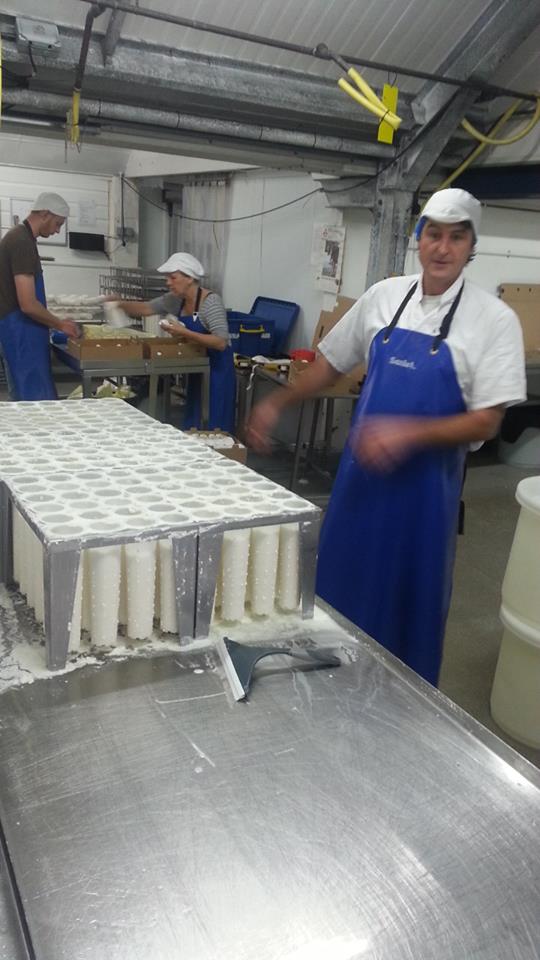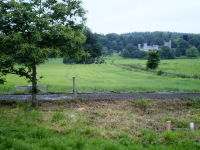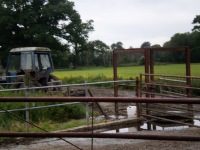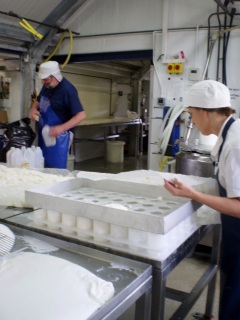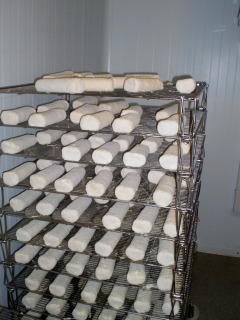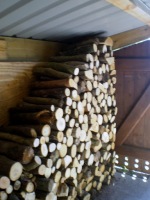Following on from Nettlebed Creamery, I was very pleased to be offered work at Andy Swinscoe’s The Courtyard Dairy, a tiny cheese shop, overflowing with artisan cheeses from small producers. It is a postage stamp sized shop that punches above its weight. Not unlike Neal’s Yard Dairy in the early days.
The job on offer was retail (of course) with some cheesemaker work thrown in. Andy had contacts with several local producers making cheese on an extremely small scale. They were interested in moving from cheesemaking as a hobby to something that might bring in an income and had got in touch with him for help. With a view to this, even before I had begun work in the Courtyard Dairy’s shop, we began to visit and make cheese at these farms to get an idea of what we might be able to do to help.
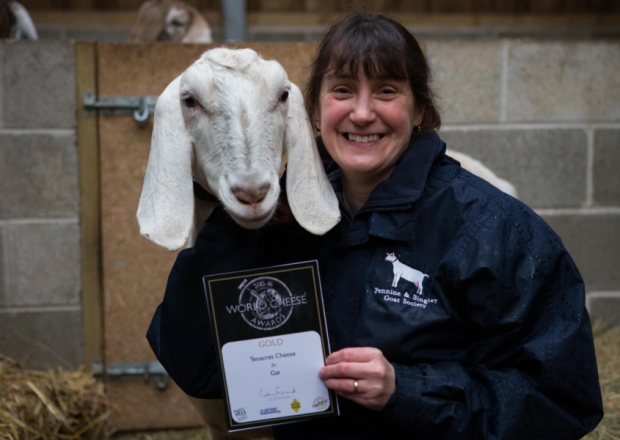
Gillian & Tim Clough, Lactic set goats cheese
Gillian’s interest in cheesemaking was a secondary string to her bow arising out of her breeding Anglo Nubian goats. She loves the breed and luckily they are known for their exceptionally rich milk which is highly prized by the goats milk cheesemaker.
As her herd increased in size, Gillian had milk than she could drink and began to think about cheese. She currently makes a lactic-set, fresh goats cheese which she began to sell at farmers markets and to a local organic deli in Hebden Bridge near her home. Having been a little bit ambivalent about cheese while growing up as she was only really exposed to anonymous supermarket cheeses, she saw the cheesemaking as something that allowed her to continue to breed goats rather than a pleasure itself. It came as a very pleasant surprise to discover that a hand made cheese, using milk from exceptionally well looked after goats was like night and day compared to the cheeses of her childhood and opened a world of characterful hand-made cheeses to her.
Last year, Gillian was milking only 4 goats which is set to jump to 8 this year. She was saving milk from a couple of days milking in order to have enough to make a batch. However she could see that as the milking herd increased in size she would need another customer. Luckily for her, Andy is always on the look out for unpasteurised, hand made Yorkshire cheeses. Together they are working on a lactic cheese that can be aged a little, for about 7 days, and sold with a very slight geotrichum, wrinkly rind.
I visited Gillian with Andy, over the summer to see her current cheese-making facilities and see the space she could expand into for maturing the cheese. She had been playing with maturing some cheeses in a wine fridge but knew that she needed to make these facilities a little bit more sophisticated. She didn’t want to set up something huge and complicated though. She doesn’t currently intend to let the herd get beyond 20 milking goats as she feels that she would have to choose between time spent on the cheese and time spent with the animals if her production increased beyond this size.
They live on the slopes of a steep hill, just out of Hebden Bridge in West Yorkshire with an amazing view down the valley. The goats are pretty much in goat heaven; as cared for as pets, glowing with health, tame as anything, inquisitive and friendly. I had a 24 hour ‘the Good Life’ pang as we visited, wondering if in fact I should buy 4 goats and start milking. It’s that attractive from the outside.
Their house is set out over 3 floors and around a circular staircase. The cheesemaking facilities are on the lowest floor which is partially dug into the hillside and that helps its temperature regulation. She has a small cheeseroom with one tiny window. Not enough to see an expansive view but enough to let air in to keep the temperature stable in summer and not so much that it cools too much in spring and autumn. The curd is set in a small vat and temperature in the room is regulated with bar heaters that you can use in a greenhouse. It is a masterclass in simple but effective ways you can start making cheese without spending a fortune.
Next to the cheeseroom is a spare room containing a couple of wine fridges and over the course of this winter, before the goats begin milking again, her husband would be beginning work to turn it into a more sophisticated set of maturing conditions. Andy and I, gave a few opinions on how the cheese might be tinkered with, suggestions of where to buy starter and starter quantities, suggestions of rennet and the most pressing issue – who to visit to see how to take her maturing facilities up a notch but without breaking the bank. One name sprang to mind, Neal’s Yard Creamery. We arranged a visit on a misty, rainy day in November. Gillian and Tim weren’t milking anymore so they had enough time on their hands to take a day out. We variously made our way from Yorkshire to Herefordshire; Andy and I in the car, Gillian and Tim by train. Neal’s Yard Creamery has grown organically and they have a particular aptitude for finding a simple way to achieve the right conditions for their cheese. Rather than put in an expensive and custom engineered drying room system, they use dehumidifiers, fans and heaters to achieve the same effect. Rather than have the latest in refrigeration design, they have bought beer coolers which refrigerate while maintaining humidity and do the job of an expensive bit of kit yet are simple to operate, don’t cost the earth and can be fixed when things go wrong. I encountered some of the disadvantages of the custom made approach while at Nettlebed Creamery so the simplicity of Neal’s Yard Creamery struck a chord. The visit was a lot of travel time for a short amount of time in the dairy but it served its purpose with Gillian and Tim taking photo after photo of equipment and mentally filing ideas away for them to work on in early 2016. Currently work is nearly finishing, with Gillian getting ready to start the kidding and milking process. The cheese year will be starting out. With a bit of luck you may see her cheese hitting the counter of the Courtyard Dairy quite soon.
